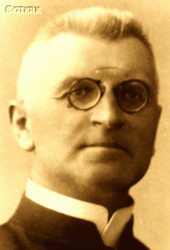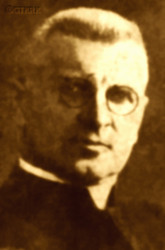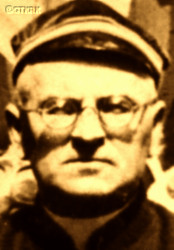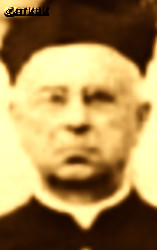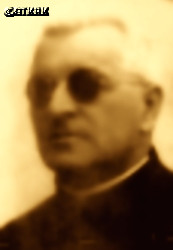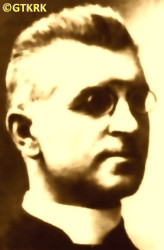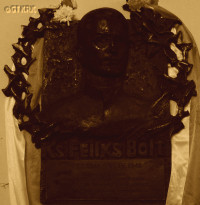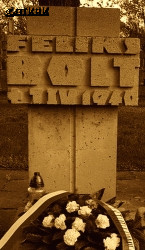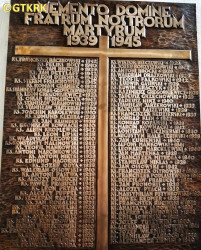Roman Catholic
St Sigismund parish
05-507 Słomczyn
85 Wiślana Str.
Konstancin deanery
Warsaw archdiocese, Poland
full list:
displayClick to display full list

searchClick to search full list by categories
wyświetlKliknij by wyświetlić pełną listę po polsku

szukajKliknij by przeszukać listę wg kategorii po polsku

Martyrology of the clergy — Poland
XX century (1914 – 1989)
personal data
surname
BOLT
forename(s)
Felix (pl. Feliks)
function
diocesan priest
creed
Latin (Roman Catholic) Church RCmore on
en.wikipedia.org
[access: 2014.09.21]
diocese / province
Culm (Chełmno) diocesemore on
pl.wikipedia.org
[access: 2012.11.23]
date and place
of death
07.04.1940

KL Stutthofconcentration camp
today: Sztutowo, Sztutowo gm., Nowy Dwór Gdański pov., Pomerania voiv., Poland
more on
en.wikipedia.org
[access: 2022.01.09]
details of death
While studying at the Germ. Königliches Katholisches Gymnasium (Eng. Royal Catholic Gymnasium) in Chełmno — during German occupation (Prussian partition of Poland) — member and c. 1880 leader of Polish clandestine self–education organization Pomeranian Philomaths. Contributed also to the establishment of a similar conspiratorial unit in 1884 in the Germ. Königlichen Gymnasium und Realgymnasium (Eng. Royal Gymnasium and Real Gymnasium) in Toruń. Expelled from the school and placed under German police supervision. Had to take his high school matura exams externally, in Chojnice.
Supported Polish Electoral Committees and Polish candidates in the Germ. Provinz Westpreußen (Eng. Province of West Prussia) for the Germ. Preußischer Landtag (Eng. Prussian National Parliament)‐elections took place in 1908 and 1913‐and for the Germ. Reichstag (Eng. Reich Parliament) of the German Empire‐elections took place in 1907 and 1912‐by speaking at election rallies. In 1913, ran for deputy to the Germ. Preußischer Landtag, as president of the Electoral Society in Wąbrzeźno and a member of the Provincial and Central Electoral Committees, but did not receive the necessary number of votes.
From 1916 involved in the activities of the clandestine Polish Citizens' Committee, and from 07.1918 the Central Citizens' Committee — changed on 11.11.1918 into the People's Council and three days later into the Supreme People's Council, gathering all the anti–German forces in the Prussian partition of Poland.
After the end of World War I on 11.11.1918 — on that day, in Compiègne, in the HQ train of Marshal of France Ferdinand Foch, an armistice was signed between the Allies and Germany; on the same day, the Regency Council established by the Germans, operating in the area occupied by the Germans, the so‐called Germ. Generalgouvernement (Eng. General Governorate), transferred the supreme authority over the army to Brigadier Joseph Piłsudski and appointed him commander‐in‐chief of the Polish army, which de facto meant the rebirth of the Polish state — took part in the Polish District Parliament (Seym) in Poznań, at which on 03‐05.12.1918 the delegates from the lands of the Prussian (German) partition, i.e. Greater Poland, Gdańsk Pomerania, Silesia and Warmia and Mazury, expressed, among others, the will to create a united Polish state with access to the sea.
Orgnised aid for the insurgents of the Greater Poland Uprising of 1918‐1919 and the Silesian Uprisings of 1919‐1921.
From 01.1920 to 1922 was also deputy commissioner in the international Commission for the Demarcation of the Polish‐Gdańsk Border, i.e. between Poland and the Free City of Gdańsk, established under the Treaty of Versailles, concluded on 28.06.1919, which ended World War I.
During the Second Polish Republic, member of Polish parliament and senator, for many terms.
After German and Russian invasion of Poland in 09.1939 and start of the World War II, after start of German occupation, arrested by the Germans on 24.10.1939 in Srebrniki.
Held in VSH Dembowalonka camp in Dębowa Łąka and from 07.12.1939 in VSH Culm camp in Chełmno.
Next on 21.03.1940 transported to KL Stutthof concentration camp where soon perished, totally exhausted.
Fellow prisoner, Fr Adalbert Gajdus described his last hours on this earth as follows: „They bring to the revier (Eng. camp hospital) Fr Felix Bolt, a 75‐year‐old man, an outstanding Pomeranian activist, member of parliament and senator of the Republic of Poland. They lay him on a pallet. Soon his life ends […] His entire life was a fight, a fight to the end, for Polish Pomerania. Uncompromising, accessible to all human feelings, he did not know only one feeling — fear. Was great. Personally, acquired neither wealth nor honors in Poland […] but was great, greater than all human honors and dignities. Rich in respect and love of the Pomeranian people, whose spokesman was at the throne of the Republic of Poland and whose intercessor before God. Was led over the threshold as a 75‐year‐old man with the honors of a newly appointed canon to the stalls. Dominated here too. And here was a lord, a senator. And here commanded respect. Was placed in the coffin by those for whom lived — young Poles. They carry him across the courtyard to the truck. A coffin, raised high, passes our windows. There are no wreaths, speeches, priests, or banners. Lived modestly and that is how they bury him. A man of one piece, a senator of the Republic of Poland. His love was Poland, and his goal was God”.
prisoner camp's numbers
9234Click to display source page (KL StutthofClick to display the description)
cause of death
extermination: exhaustion and starvation
perpetrators
Germans
sites and events
KL StutthofClick to display the description, VSH CulmClick to display the description, VSH DembowalonkaClick to display the description, «Intelligenzaktion»Click to display the description, Reichsgau Danzig‐WestpreußenClick to display the description, Ribbentrop‐MolotovClick to display the description, Pius XI's encyclicalsClick to display the description, Pomeranian PhilomathsClick to display the description
date and place
of birth
07.01.1864

Barłożnotoday: Skórcz gm., Starogard Gdański pov., Pomerania voiv., Poland
more on
en.wikipedia.org
[access: 2021.09.02]
parents
BOLT Joseph Luke
🞲 18.10.1926, Barłożnotoday: Skórcz gm., Starogard Gdański pov., Pomerania voiv., Poland
more on
en.wikipedia.org
[access: 2021.09.02] — 🕆 19.01.1897, Barłożnotoday: Skórcz gm., Starogard Gdański pov., Pomerania voiv., Poland
more on
en.wikipedia.org
[access: 2021.09.02]

GAJKOWSKA Joanna Veronica
🞲 01.02.1826, Barłożnotoday: Skórcz gm., Starogard Gdański pov., Pomerania voiv., Poland
more on
en.wikipedia.org
[access: 2021.09.02] — 🕆 23.05.1900, Barłożnotoday: Skórcz gm., Starogard Gdański pov., Pomerania voiv., Poland
more on
en.wikipedia.org
[access: 2021.09.02]
baptism
14.01.1864

Barłożnotoday: Skórcz gm., Starogard Gdański pov., Pomerania voiv., Poland
more on
en.wikipedia.org
[access: 2021.09.02]
St Martin the Bishop and Confessor RC church
presbyter (holy orders)
ordination
15.03.1891

Pelplintoday: Pelplin gm., Tczew pov., Pomerania voiv., Poland
more on
en.wikipedia.org
[access: 2021.05.06]
positions held
1937 – 1939
parish priest — Srebrnikitoday: Kowalewo Pomorskie gm., Golub‐Dobrzyń pov., Kuyavia‐Pomerania voiv., Poland
more on
en.wikipedia.org
[access: 2021.12.18] ⋄ Our Lady of the Snow RC parish ⋄ Golubtoday: district of Golub‐Dobrzyń, Golub‐Dobrzyń gm., Golub‐Dobrzyń pov., Kuyavia‐Pomerania voiv., Poland
more on
en.wikipedia.org
[access: 2021.09.02] RC deanery
1927 – 1937
curatus/rector/expositus — Srebrnikitoday: Kowalewo Pomorskie gm., Golub‐Dobrzyń pov., Kuyavia‐Pomerania voiv., Poland
more on
en.wikipedia.org
[access: 2021.12.18] ⋄ Our Lady of the Snow RC church ⋄ Kowalewotoday: Kowalewo Pomorskie, Kowalewo Pomorskie gm., Golub‐Dobrzyń pov., Kuyavia‐Pomerania voiv., Poland
more on
en.wikipedia.org
[access: 2021.12.19], St Nicholas the Bishop and Confessor RC parish ⋄ Golubtoday: district of Golub‐Dobrzyń, Golub‐Dobrzyń gm., Golub‐Dobrzyń pov., Kuyavia‐Pomerania voiv., Poland
more on
en.wikipedia.org
[access: 2021.09.02] RC deanery — from 1929 formally „professor” in schools, in accordance with Art. 8 of the 01.07.1926 Act of Polish Parlament; also: from 1935 member of the Main Committee of the National Party
1930 – 1935
senator — Senate of the 3rd Term of the Second Polish Republic — chairman of the Social Work Commission; also: 1928‐1935 chairman of the National Party in the Pomeranian Voivodeship
12.01.1900 – 1927
curatus/rector/expositus — Srebrnikitoday: Kowalewo Pomorskie gm., Golub‐Dobrzyń pov., Kuyavia‐Pomerania voiv., Poland
more on
en.wikipedia.org
[access: 2021.12.18] ⋄ Our Lady of the Snow RC church ⋄ Kiełbasintoday: Chełmża gm., Toruń pov., Kuyavia‐Pomerania voiv., Poland
more on
en.wikipedia.org
[access: 2022.02.24], Nativity of the Blessed Virgin Mary RC parish ⋄ Chełmżatoday: Chełmża urban gm., Toruń pov., Kuyavia‐Pomerania voiv., Poland
more on
en.wikipedia.org
[access: 2021.09.02] RC deanery
1922 – 1927
senator — Senate of the 1st Term of the Second Polish Republic — member of the Treasury and Budget Commission; also: 1920‐1928 president of the Provincial Council of the People's National Union; 1924‐1926 member of the diocesan board of the „Unitas” Priests' Union
1919 – 1922
parliamentary deputy — Seym i.e. Parliament (Legislative), Second Polish Republic — i.a. the chairman of the Maritime Commission
vicar — Raciążtoday: Tuchola gm., Tuchola pov., Kuyavia‐Pomerania voiv., Poland
more on
en.wikipedia.org
[access: 2021.09.02] ⋄ Holy Trinity RC parish ⋄ Tucholatoday: Tuchola gm., Tuchola pov., Kuyavia‐Pomerania voiv., Poland
more on
en.wikipedia.org
[access: 2021.09.02] RC deanery
vicar — Kielnotoday: Szemud gm., Wejherowo pov., Pomerania voiv., Poland
more on
en.wikipedia.org
[access: 2022.01.28] ⋄ St Adalbert the Bishop and Martyr RC parish ⋄ Gdańsk IIdeanery name
today: Gdańsk city pov., Pomerania voiv., Poland
more on
en.wikipedia.org
[access: 2021.07.04] RC deanery
1897 – 1898
vicar — Brusytoday: Brusy gm., Chojnice pov., Pomerania voiv., Poland
more on
en.wikipedia.org
[access: 2021.09.02] ⋄ All the Saints RC parish ⋄ Tucholatoday: Tuchola gm., Tuchola pov., Kuyavia‐Pomerania voiv., Poland
more on
en.wikipedia.org
[access: 2021.09.02] RC deanery
1895 – 1897
curatus/rector/expositus — Lutowotoday: Sępólno Krajeńskie gm., Sępólno Krajeńskie pov., Kuyavia‐Pomerania voiv., Poland
more on
en.wikipedia.org
[access: 2021.09.02] ⋄ St Lawrence the Deacon and Martyr RC church ⋄ Kamień Pomorskitoday: Kamień Krajeński, Kamień Krajeński gm., Sępólno Krajeńskie pov., Pomerania voiv., Poland
more on
en.wikipedia.org
[access: 2021.09.02], Blessed Virgin Mary and St Peter and St Paul the Apostles RC parish ⋄ Kamień Pomorskitoday: Kamień Krajeński, Kamień Krajeński gm., Sępólno Krajeńskie pov., Pomerania voiv., Poland
more on
en.wikipedia.org
[access: 2021.09.02] RC deanery
1894 – 1895
administrator — Bobowotoday: Bobowo gm., Starogard Gdański pov., Pomerania voiv., Poland
more on
en.wikipedia.org
[access: 2022.02.14] ⋄ St Adalbert the Bishop and Martyr RC parish ⋄ Starogard Gdańskitoday: Starogard Gdański gm., Starogard Gdański pov., Pomerania voiv., Poland
more on
en.wikipedia.org
[access: 2021.06.07] RC deanery
vicar — Wieletoday: Korsin gm., Kościerzyna pov., Pomerania voiv., Poland
more on
en.wikipedia.org
[access: 2022.01.28] ⋄ St Nicholas the Bishop and Confessor RC parish ⋄ Tucholatoday: Tuchola gm., Tuchola pov., Kuyavia‐Pomerania voiv., Poland
more on
en.wikipedia.org
[access: 2021.09.02] RC deanery
vicar — Śliwicetoday: Śliwice gm., Tuchola pov., Kuyavia‐Pomerania voiv., Poland
more on
en.wikipedia.org
[access: 2010.08.11] ⋄ St Catherine of Alexandria the Virgin and Martyr RC parish ⋄ Świecietoday: Świecie gm., Świecie pov., Kuyavia‐Pomerania voiv., Poland
more on
en.wikipedia.org
[access: 2021.09.02] RC deanery
1897 – 1920
membership — Toruńtoday: Toruń city pov., Kuyavia‐Pomerania voiv., Poland
more on
en.wikipedia.org
[access: 2021.06.20] ⋄ scientific society
1888 – 1891
student — Pelplintoday: Pelplin gm., Tczew pov., Pomerania voiv., Poland
more on
en.wikipedia.org
[access: 2021.05.06] ⋄ philosophy and theology, Theological Seminary
till 1888
student — Munichtoday: Bavaria state, Germany
more on
en.wikipedia.org
[access: 2022.04.12] ⋄ theology — studies outside the diocese, due to the closure of the Theological Seminary in Peplin in the years 1876‐1887, caused by the anti–Catholic and anti–Polish German policy, which went down in history as the Kulturkampf
from 1887
student — Münstertoday: Münster urban dist., Münster reg., North Rhine‐Westphalia state, Germany
more on
en.wikipedia.org
[access: 2021.07.18] ⋄ theology — studies outside the diocese, due to the closure of the Theological Seminary in Peplin in the years 1876‐1887, caused by the anti–Catholic and anti–Polish German policy, which went down in history as the Kulturkampf
1987
pupil — Chojnicetoday: Chojnice urban gm., Chojnice pov., Pomerania voiv., Poland
more on
en.wikipedia.org
[access: 2021.09.02] ⋄ Germ. Königliche Katholische Gymnasium (Eng. Royal Catholic Gymnasium) — studies crowned on 26.02.1887 with an extramural — after the Prussian authorities had expelled him from the gymnasium in Chełmno — maturity diploma (i.e. matura)
from 16.04.1882
pupil — Chełmnotoday: Chełmno urban gm., Chełmno pov., Kuyavia‐Pomerania voiv., Poland
more on
en.wikipedia.org
[access: 2021.07.25] ⋄ Germ. Königliche Katholische Gymnasium (Eng. Royal Catholic Gymnasium)
1874 – 1882
pupil — Pelplintoday: Pelplin gm., Tczew pov., Pomerania voiv., Poland
more on
en.wikipedia.org
[access: 2021.05.06] ⋄ „Collegium Marianum” progymnasium
from 1930 member of the Society for the Study of the Independence Movement in Pomerania, established in Toruń; from 1926 member of the Pomeranian Brotherhood in Toruń; 1921 co‐organizer of the Pomeranian Philomaths Association, established in Chełmno; member of the Scientific Aid Society in Chełmno; member of the People's Reading Rooms Society TCL in Poznań; honorary member of the Student Corporation of the University of Poznań „Baltia”, founded on 07.12.1921 in Poznań
known as the „father of Polish commerce in Pomerania”; from 17.02.1920 shareholder and chairman of the Supervisory Board of the Publishing Joint‐Stock Company „Gazeta Gdańska”, publishing Polish periodicals, including pl. „Gazeta Gdańska” (Eng. „Gdańsk Newspaper”); 1917‐1931 member of the Supervisory Board of the Bank of the Association of Commercial and Business Companies in Poznań; from 1912 organizer, shareholder and chairman of the Supervisory Board of the Polish Publishing Company in Chojnice, publishing Polish periodicals, including pl. „Gazeta Chojnicka” (Eng. „Chojnice Newspaper”); collaborator and author of articles in the magazine „Pielgrzym” published in Pelplin; 1906‐1915 president and vice‐president of the Supervisory Board of the pl. Bank Ludowy (Eng. People’s Bank) in Kowalewo Pomorskie; 1904 member, 1922‐1934 vice‐president of the Patronage of the Association of Commercial and Business Companies in Poznań; 1904 co‐organizer of the joint‐stock company pl. „Bazar” (Eng. „Market”) in Brusy; 1901‐1912 director of the management board of the agricultural products trading company pl. „Rolnik” (Eng. „Farmer”) in Pelplin, with its seat in Toruń, covering the entire area of the Germ. Provinz Westpreußen (Eng. Province of West Prussia); vice‐president, secretary and, in 1900, organizer of the Central Agricultural Society for West Prussia; 24.01.1898 co‐organizer of the company pl. „Kupiec” (Eng. „Merchant”) in Brusy, which covered the northern part of Pomerania, taking the textile market away from German and Jewish companies.
others related
in death
BORKOWSKIClick to display biography Paul, BRUDNICKIClick to display biography Alexander Casimir, BRZEZIŃSKIClick to display biography Paul John, CZAPLEWSKIClick to display biography John Bruno, DOMACHOWSKIClick to display biography Joseph, FARULEWSKIClick to display biography Thaddeus, GÓRECKIClick to display biography Marian, GRABOWSKI–WIDŁAKClick to display biography Casimir, GUMPERTClick to display biography Steven Edward, KALINOWSKIClick to display biography Anthony, KARBAUMClick to display biography Ernest, KOMOROWSKIClick to display biography Bronislav Boleslav, KREFFTClick to display biography Constantine Francis, KUBICKIClick to display biography Telesphorus, LESIŃSKIClick to display biography Alexander, LESIŃSKIClick to display biography John, ŁĘGOWSKIClick to display biography Vladislav Leonard, MALINOWSKIClick to display biography Thaddeus, MAŁKOWSKIClick to display biography Julius, MAŃKOWSKIClick to display biography Alphonse, MATERNICKIClick to display biography Vladislav, MAZELLAClick to display biography John, NIEMIRClick to display biography Joseph, OSSOWSKIClick to display biography Valerian, POŁOMSKIClick to display biography Leo Louis John, RODZIŃSKAClick to display biography Stanislava (Sr Mary Julia), ROGACZEWSKIClick to display biography Francis Xavier, RÓŻYCKIClick to display biography Mieczyslav Bogumil, RYGLEWICZClick to display biography John, SĄDECKIClick to display biography Bernard, SARNOWSKIClick to display biography Joseph, SCHULZClick to display biography Alphonse Vaclav, SEPEŁOWSKIClick to display biography Vaclav, SMOLEŃSKIClick to display biography Bronislav, SROKAClick to display biography Leo Florian, SZWEDOWSKIClick to display biography Ignatius Mieczyslav, SZYMAŃSKIClick to display biography John Joseph, SZYMAŃSKIClick to display biography Vladislav, WIECKIClick to display biography Bernard Anthony, WILMOWSKIClick to display biography John, BĄCZKOWSKIClick to display biography Francis, BREJSKIClick to display biography John Casimir, CHARSZEWSKIClick to display biography Paulinus Ignatius, DEKOWSKIClick to display biography Francis, DERKACZEWSKAClick to display biography Stanislava (Sr Raphaella of the Holy Face), GALIKOWSKIClick to display biography Roman John, GNILKAClick to display biography Pauline (Sr Junilla), JARZĘBSKIClick to display biography Stanislav Romualdo, JONEKClick to display biography Martha (Sr Dygna), KOWNACKIClick to display biography Bronislav, KOWNACKIClick to display biography Martin Stanislav, KUCZAClick to display biography Francesca (Sr Gorgonya), LICZNERSKIClick to display biography Constantine John, RUCIŃSKIClick to display biography Francis, WILEMSKIClick to display biography Joseph Louis, ZAREMBAClick to display biography Felix Joseph Hubert, ZIEMIAŁKOWSKAClick to display biography Hedwig (Sr Dominica of the Sacred Wounds of Jesus), MARCHLEWSKIClick to display biography Leonard, ŚWIECZKOWSKIClick to display biography Alexander, ZIELIŃSKIClick to display biography Paul Nicholas
sites and events
descriptions
KL Stutthof: In German Germ. Konzentrationslager (Eng. concentration camp) KL Stutthof (then in Eastern Prussian belonging to Germany, today: Sztutowo village) concentration camp, that Germans started to build on 02.09.1939, a day after German invasion of Poland and start of the World War II, Germans held c. 110,000‐127,000 prisoners from 28 countries, including 49,000 women and children. C. 65,000 victims were murdered and exterminated. In the period of 25.01‐27.04.1945 in the face of approaching Russian army Germans evacuated the camp. When on 09.05.1945 Russians soldiers entered the camp only 100 prisoners were still there. In an initial period (1939‐1940) Polish Catholic priests from Pomerania were held captive there before being transported to KL Dachau concentration camp. Some of them were murdered in KL Stutthof or vicinity (for instance in Stegna forest). Also later some Catholic priests were held in KL Stutthof. (more on: stutthof.orgClick to attempt to display webpage
[access: 2018.11.18], en.wikipedia.orgClick to attempt to display webpage
[access: 2013.07.06])
VSH Culm: German Germ. Volksdeutscher Selbstschutzhaft (Eng. Volksdeutscher Selbstschutz custody) VSH, founded by the Germans in Chełmno. The main role in it was played by members of the genocidal paramilitary formation Germ. Volksdeutscher Selbstschutz — the decision to create Selbstschutz in the Polish lands occupied by German troops was made in Berlin on 08‐10.09.1939 at a conference headed by Reichsführer‐SS Heinrich Himmler (the formal order bears the data 20.09.1939), and the chaotically formed units were directly subordinated to the officers of the genocidal SS organization. As part of the «Intelligenzaktion» operation, i.e. the extermination of the Polish intelligentsia and leadership classes, the Germans held thousands of Poles in the court prison building in Chełmno, in temporary detention centers set up in the buildings of primary schools No. 1 and No. 2 in Chełmno, in a makeshift camp set up in the old Fort VIII in Klamry (part of the former Prussian Chełmno Fortress), and also from 10.1939 in the convent of the Daughters of Charity, i.e. the Grey Sisters FdlC in Chełmno (where from 07.12.1939 a dozen or so Polish priests were interned, brought mainly from the VSH Dembowalonka internment camp). A significant number of those held, including c. 19 Catholic priests, were murdered in Klamry; some were transported to the KL Stutthof concentration camp (including, on 22.03.1940, many Catholic priests who remained in custody, most of whom were also subsequently murdered). (more on: pl.wikipedia.orgClick to attempt to display webpage
[access: 2014.03.10])
VSH Dembowalonka: German Germ. Volksdeutscher Selbstschutzhaft (Eng. Volksdeutscher Selbstschutz custody) VSH for the clergy of Wąbrzeźno county. Established on 24‐25.09.1939, when Germans, members of the genocidal paramilitary Germ. Volksdeutscher Selbstschutz formation — the decision to create Selbstschutz in the Polish lands occupied by German troops was made in Berlin on 08‐10.09.1939 at a conference headed by Reichsführer‐SS Heinrich Himmler (the formal order bears the date 20.09.1939), and the chaotically formed units were directly subordinated to the officers of the genocidal SS organization ‐ in the Shepherd Sisters CSDP monastery–institute in Dębowa Łąka, c. 10 km from Wąbrzeźno, interned 30 Catholic priests from nearby parishes (on the same day, the Germans destroyed all roadside statues and crosses in Wąbrzeźno district). As part of the «Intelligenzaktion» operation — the extermination of the Polish intelligentsia (in Kurkocin, c. 4 km away, the Germans murdered then c. 500 Poles) — they were detained there till 06.12.1939, and then transported to another camp in Chełmno and next to KL Stutthof concentration camp. After the end of hostilities of World War II, in the years 1954‐1957, during the Russian occupation, one of the concentration and slave labor camps organized by Commie‐Nazi authorities in Russian republic prl for religious sisters and nuns during «Action X‐2». (more on: pl.wikipedia.orgClick to attempt to display webpage
[access: 2014.10.31])
«Intelligenzaktion»: German: «Intelligenzaktion» (English: „Intelligence Action”) — a German program of extermination of the Polish elite, mainly the intelligentsia and leadership layers, carried out from the beginning of the occupation in w 09.1939 to 04.1940, mainly in territories directly annexed to Germany, but also in the so‐called Germ. Generalgouvernement (Eng. General Governorate), where it was called «AB‐aktion». In the first phase, immediately after the beginning of the German occupation, during military operations carried out by the Germ. Wehrmacht (Eng. Armed Forces) and the genocidal units of the Germ. Einsatzgruppen (Eng. Operational Groups) of the Germ. Sicherheitspolizei (Eng. Security Police), i.e. SiPo, and Germ. Sicherheitsdienst des Reichsführers SS (Eng. Security Service of the Reichsführer SS), i.e. SD, organized by the Germ. Reichssicherheitshauptamt (Eng. Reich Main Security Office), i.e. RSHA, which followed the troops, carried out under the Germ. Unternehmen „Tannenberg” (Eng. Operation „Tannenberg”) — based on the so‐called Germ. Sonderfahndungsliste (Eng. Special Wanted Lists), i.e. proscription lists of Poles considered particularly dangerous to the Third Reich, prepared by the Zentralstelle II/P (Polen) unit of the German RSHA. Later, implemented by the German civilian occupation authorities and the genocidal unit of the Germ. Volksdeutscher Selbstschutz (Eng. Ethnic Germans Self‐Defense), whose members were Germ. Volksdeutsche (Eng. Ethnic Germans), i.e. representatives of the German minority in Poland. According to various sources, these lists, at the beginning of 09.1939, could have contained the details of 61,000—88,000 „dangerous” Poles — although these figures cannot be confirmed. In total, during this genocide, c. 50,000 teachers, Catholic priests, representatives of the landed gentry, freelancers, social and political activists, and retired military personnel were systematically and methodically murdered. Another 50,000 were sent to concentration camps, where only a negligible percentage survived. (more on: en.wikipedia.orgClick to attempt to display webpage
[access: 2014.10.04])
Reichsgau Danzig‐Westpreußen: After the Polish defeat in the 09.1939 campaign, which was the result of the Ribbentrop‐Molotov Pact and constituted the first stage of World War II, and the beginning of German occupation in part of Poland (in the other, eastern part of Poland, the Russian occupation began), the Germans divided the occupied Polish territory into five main regions (and a few smaller). The largest one was transformed into Germ. Generalgouvernement (Eng. General Governorate), intended exclusively for Poles and Jews and constituting part of the so‐called Germ. Großdeutschland (Eng. Greater Germany). Two were added to existing German provinces. From two other separate new provinces were created. Vistula Pomerania region was one of them, incorporated into Germany on 08.10.1939, by decree of the German leader Adolf Hitler (formally came into force on 26.10.1939), and on 02.11.1939 transformed into the Germ. Reichsgau Danzig‐Westpreußen (Eng. Reich District of Gdańsk‐West Prussia) province, in which the law of the German state was to apply. The main axis of the policy of the new province, the territory of which the Germans recognized as the Germ. „Ursprünglich Deutsche” (Eng. „natively German”), despite the fact that 85% of its inhabitants were Poles, was Germ. „Entpolonisierung” (Eng. „Depolonisation”), i.e. forced Germanization. C. 60,000 Poles were murdered in 1939‐1940, as part of the Germ. „Intelligenzaktion”, i.e. extermination of Polish intelligentsia and ruling classes, in c. 432 places of mass executions — including c. 220 Polish Catholic priests. The same number were sent to German concentration camps, from where few returned (over 300 priests were arrested, of whom c. 130 died in concentration camps). C. 124,000‐170,000 were displaced, including c. 90,000 to the Germ. Generalgouvernement. Poles were forced en masse to sign the German nationality list, the Germ. Deutsche Volksliste DVL. Polish children could only learn in German. It was forbidden to use the Polish language during Catholic Holy Masses and during confession. Polish landed estates were confiscated..To further reduce the number of the Polish population, Poles were sent to forced labor deep inside Germany. The remaining Poles were treated as low‐skilled labor, isolated from the Germans and strictly controlled — legally, three or three of them could only meet together, even in their own apartments. Many were conscripted into the German Wehrmacht army. After the end of hostilities of World War II, the overseer of this province, the Germ. Reichsstatthalter (Eng. Reich Governor) and the Germ. Gauleiter (Eng. district head) of the German National Socialist Party, Albert Maria Forster, was executed. (more on: en.wikipedia.orgClick to attempt to display webpage
[access: 2024.06.24])
Ribbentrop‐Molotov: Genocidal Russian‐German alliance pact between Russian leader Joseph Stalin and German leader Adolf Hitler signed on 23.08.1939 in Moscow by respective foreign ministers, Mr. Vyacheslav Molotov for Russia and Joachim von Ribbentrop for Germany. The pact sanctioned and was the direct cause of joint Russian and German invasion of Poland and the outbreak of the World War II in 09.1939. In a political sense, the pact was an attempt to restore the status quo ante before 1914, with one exception, namely the „commercial” exchange of the so‐called „Kingdom of Poland”, which in 1914 was part of the Russian Empire, fore Eastern Galicia (today's western Ukraine), in 1914 belonging to the Austro‐Hungarian Empire. Galicia, including Lviv, was to be taken over by the Russians, the „Kingdom of Poland” — under the name of the General Governorate — Germany. The resultant „war was one of the greatest calamities and dramas of humanity in history, for two atheistic and anti‐Christian ideologies — national and international socialism — rejected God and His fifth Decalogue commandment: Thou shall not kill!” (Abp Stanislav Gądecki, 01.09.2019). The decisions taken — backed up by the betrayal of the formal allies of Poland, France and Germany, which on 12.09.1939, at a joint conference in Abbeville, decided not to provide aid to attacked Poland and not to take military action against Germany (a clear breach of treaty obligations with Poland) — were on 28.09.1939 slightly altered and made more precise when a treaty on „German‐Russian boundaries and friendship” was agreed by the same murderous signatories. One of its findings was establishment of spheres of influence in Central and Eastern Europe and in consequence IV partition of Poland. In one of its secret annexes agreed, that: „the Signatories will not tolerate on its respective territories any Polish propaganda that affects the territory of the other Side. On their respective territories they will suppress all such propaganda and inform each other of the measures taken to accomplish it”. The agreements resulted in a series of meeting between two genocidal organization representing both sides — German Gestapo and Russian NKVD when coordination of efforts to exterminate Polish intelligentsia and Polish leading classes (in Germany called «Intelligenzaktion», in Russia took the form of Katyń massacres) where discussed. Resulted in deaths of hundreds of thousands of Polish intelligentsia, including thousands of priests presented here, and tens of millions of ordinary people,. The results of this Russian‐German pact lasted till 1989 and are still in evidence even today. (more on: en.wikipedia.orgClick to attempt to display webpage
[access: 2015.09.30])
Pius XI's encyclicals: Facing the creation of two totalitarian systems in Europe, which seemed to compete with each other, though there were more similarities than contradictions between them, Pope Pius XI issued in 03.1937 (within 5 days) two encyclicals. In the „Mit brennender Sorge” (Eng. „With Burning Concern”) published on 14.03.1938, condemned the national socialism prevailing in Germany. The Pope wrote: „Whoever, following the old Germanic‐pre‐Christian beliefs, puts various impersonal fate in the place of a personal God, denies the wisdom of God and Providence […], whoever exalts earthly values: race or nation, or state, or state system, representatives of state power or other fundamental values of human society, […] and makes them the highest standard of all values, including religious ones, and idolizes them, this one […] is far from true faith in God and from a worldview corresponding to such faith”. On 19.03.1937, published „Divini Redemptoris” (Eng. „Divine Redeemer”), in which criticized Russian communism, dialectical materialism and the class struggle theory. The Pope wrote: „Communism deprives man of freedom, and therefore the spiritual basis of all life norms. It deprives the human person of all his dignity and any moral support with which he could resist the onslaught of blind passions […] This is the new gospel that Bolshevik and godless communism preaches as a message of salvation and redemption of humanity”… Pius XI demanded that the established human law be subjected to the natural law of God , recommended the implementation of the ideal of a Christian state and society, and called on Catholics to resist. Two years later, National Socialist Germany and Communist Russia came together and started World War II. (more on: www.vatican.vaClick to attempt to display webpage
[access: 2023.05.28], www.vatican.vaClick to attempt to display webpage
[access: 2023.05.28])
Pomeranian Philomaths: Secret societies of Polish youth, aiming at self‐education, patriotic in form and content, functioning 1830‐1920, mainly in secondary schools — gymnasia — in Pomerania around Vistula river (Gdańsk Pomerania and Chełmno county), in Prussian‐occupied Polish territories (one of the partitions of Poland). On 08.01.1901 Germans conducted a series of interrogations of students at Chełmno, Brodnica and Toruń gymnasiums. On 09‐12.09.1901 the first of court trials of Polish students from those gymnasiums and students of Theological Seminary in Pelplin was held in Toruń. 1 person was sentenced to 3 months in prison, 1 to 2 months, 3 to 6 weeks, 7 to 3 weeks, 2 to 2 weeks, 19 to a week, 2 to 1 day, 10 were reprimanded. 15 were cleared. More definitive penalties were relegations from the schools with so‐called wolf’s ticket, forbidding sentenced students to continue secondary and higher studies in Prussia (Germany). Among those penalized were a few future Catholic priests — those were able to continue their education for the Chełmno diocese bishop, Bp August Rosentreter, refused to relegate students from Theological Seminary. (more on: pl.wikipedia.orgClick to attempt to display webpage
[access: 2018.11.18])
sources
personal:
www.niedziela.diecezja.torun.plClick to attempt to display webpage
[access: 2012.11.23], stutthof.orgClick to attempt to display webpage
[access: 2013.01.06], przystanekhistoria.plClick to attempt to display webpage
[access: 2025.08.19], www.opatrznosc.gda.plClick to attempt to display webpage
[access: 2013.01.13], www.poradnia-metanoia.plClick to attempt to display webpage
[access: 2013.01.13], bs.sejm.gov.plClick to attempt to display webpage
[access: 2013.07.06], pl.wikipedia.orgClick to attempt to display webpage
[access: 2013.10.05]
bibliographical:
„Biographical dictionary of priests of the Chełmno diocese ordained in the years 1821‐1920”, Henry Mross, Pelplin, 1995
original images:
www.wicipolskie.orgClick to attempt to display webpage
[access: 2015.09.30], www.historiachojnic.plClick to attempt to display webpage
[access: 2015.09.30], www.historiachojnic.plClick to attempt to display webpage
[access: 2015.09.30], www.niedziela.diecezja.torun.plClick to attempt to display webpage
[access: 2018.09.23], senat.edu.plClick to attempt to display webpage
[access: 2018.09.23], www.scribd.comClick to attempt to display webpage
[access: 2020.09.26], www.mapakultury.plClick to attempt to display webpage
[access: 2014.10.31], twitter.comClick to attempt to display webpage
[access: 2018.09.23], www.senat.edu.plClick to attempt to display webpage
[access: 2014.10.31], commons.wikimedia.orgClick to attempt to display webpage
[access: 2015.09.30], gdansk.ipn.gov.plClick to attempt to display webpage
[access: 2020.10.02]
LETTER to CUSTODIAN/ADMINISTRATOR
If you have an Email client on your communicator/computer — such as Mozilla Thunderbird, Windows Mail or Microsoft Outlook, described at WikipediaPatrz:
en.wikipedia.org, among others — try the link below, please:
LETTER to CUSTODIAN/ADMINISTRATORClick and try to call your own Email client
If however you do not run such a client or the above link is not active please send an email to the Custodian/Administrator using your account — in your customary email/correspondence engine — at the following address:

giving the following as the subject:
MARTYROLOGY: BOLT Felix
To return to the biography press below:
 Click to return to biography
Click to return to biography








